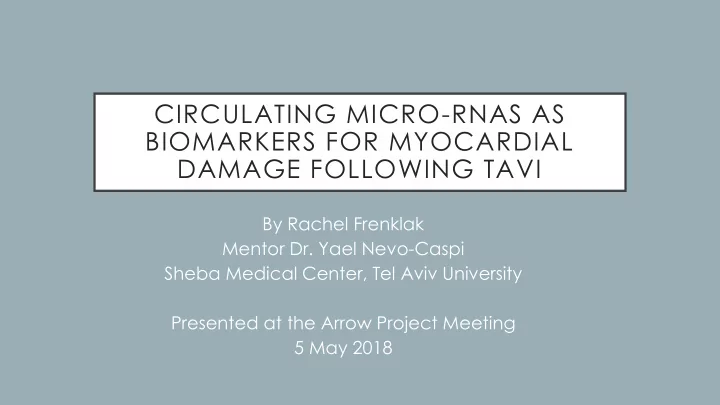

CIRCULATING MICRO-RNAS AS BIOMARKERS FOR MYOCARDIAL DAMAGE FOLLOWING TAVI By Rachel Frenklak Mentor Dr. Yael Nevo-Caspi Sheba Medical Center, Tel Aviv University Presented at the Arrow Project Meeting 5 May 2018
OBJECTIVE • Improve treatment of transcatheter aortic valve implantation (TAVI) patients following surgery by earlier detection of complications and improved forecasting of outcomes • How? • By identifying a better biomarker of myocardial damage- the current indicators, troponin and CPK, are insufficiently specific
BIOMARKERS • Biomarkers can be DNA, RNA, or protein • They are used in many areas of medicine to identify disease and damage in the body • What makes a good biomarker? • Stable in sample • Detectable in small amounts • Specific to the organ of interest • Released quickly following the change we want to follow
WHY MICRO-RNAS? • Besides for their intracellular role regulating mRNA, current research indicates they may also be released for extracellular signaling processes and through tissue damage • Other research on related topics identified the exact microRNAs measured in this study as relevant to myocardial tissue
IMMEDIATE BACKGROUND • A prior study by Dr. Yael Caspi, et. al. done in the same lab measured three myocardial-specific circulating microRNAs as biomarkers for damage before, and at successive time points following, congenital heart defect corrective surgery in children • Elevation of all three microRNAs12 hours post- operation, was predictive of longer hospital stays • And specifically elevated micro-RNA-208a, as soon as 6 hours after the operation, was predictive of complications • These microRNAs correlate with myocardial
METHODS • Blood samples are taken from patients undergoing TAVI pre-surgery and at 6, 12, and 24 hours after surgery • RNA is extracted from the plasma of these samples and cDNA is made via reverse transcriptase and amplification PCR protocol • An equal amount of C. elegans microRNA is used as the control • The cDNA of all the samples undergoes real time PCR (in triplicates) for each of the microRNAs we are seeking to quantify: 208a, 208b, and 499 • Software quantifies the relative amount of a specific microRNA in the patients’ blood at each time point • Results are compared with the medical data of the patients and analyzed for trends and correlation to
CHALLENGES • Adjusting the new cDNA/rtPCR protocol to give standardized results • More to come as we proceed!
RESULTS: WHERE ARE WE NOW? • 22 patients’ samples have been analyzed • We have molecular results only and are waiting for the medical data • microRNA 208a : undetectable in nearly all patients at all times • We know less damage is caused by TAVI than by the surgeries in the previous study • microRNA 208b : undetectable in some patients at all times while in others it was found in higher amounts 6 hours after the TAVI procedure • microRNA 499 : in most patients found to be higher at 6 hours post-TAVI, declining at 24 hours
CONCLUSIONS: WHERE ARE WE GOING? • We cannot derive conclusions just yet! • The next step is to correlate the quantities of microRNA over time with the medical data of each patient • We are looking for trends that will correlate a change in some or all of the microRNAs measured with specific events in the patients’ hospital stays
DISCUSSION OF IMPLICATIONS • Having an improved biomarker for myocardial tissue damage following TAVI, compared to what is currently used, will allow clinicians to predict earlier and more accurately their patients’ outcomes and potential complications before they occur • This information will help with allocation of time, attention, and resources to the patients who will need them more • The long-term outlook for all patients undergoing TAVI will improve if their physicians can know ahead of time their post-surgical course and will be prepared to treat them appropriately
ACKNOWLEDGEMENTS • Thank you to… • Dr. Yael Nevo-Caspi , for her time and patience explaining to me the fundamental concepts underlying this research, for welcoming me into her lab, and for keeping me updated and involved along the way, • Haya Abbas , for her efforts walking me through the complex protocols in the lab and acquainting me with the necessary equipment, • Dr. Yoni Grossman, for assisting us in the compilation of the medical data, • Prof. Anat Achiron , for giving me the opportunity to be a part of the Arrow Project, • And to Prof. Gidi Paret, and Prof. Issi Barabash for their continued support!
THANK YOU FOR LISTENING!
Recommend
More recommend